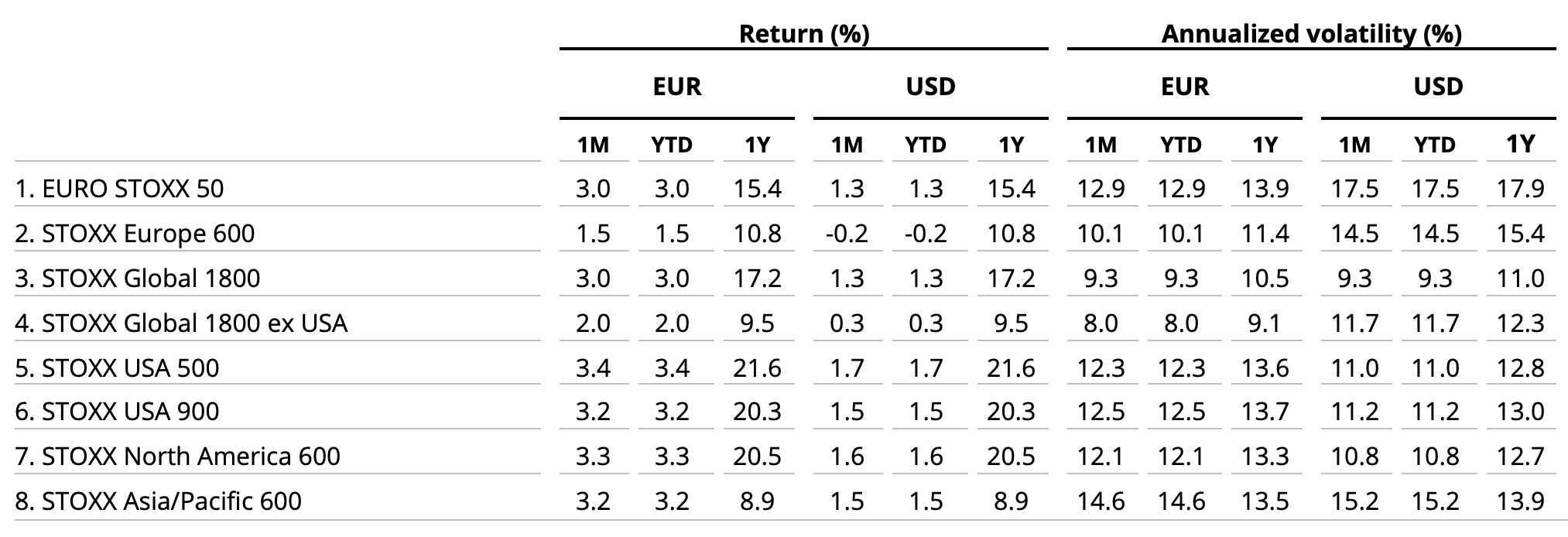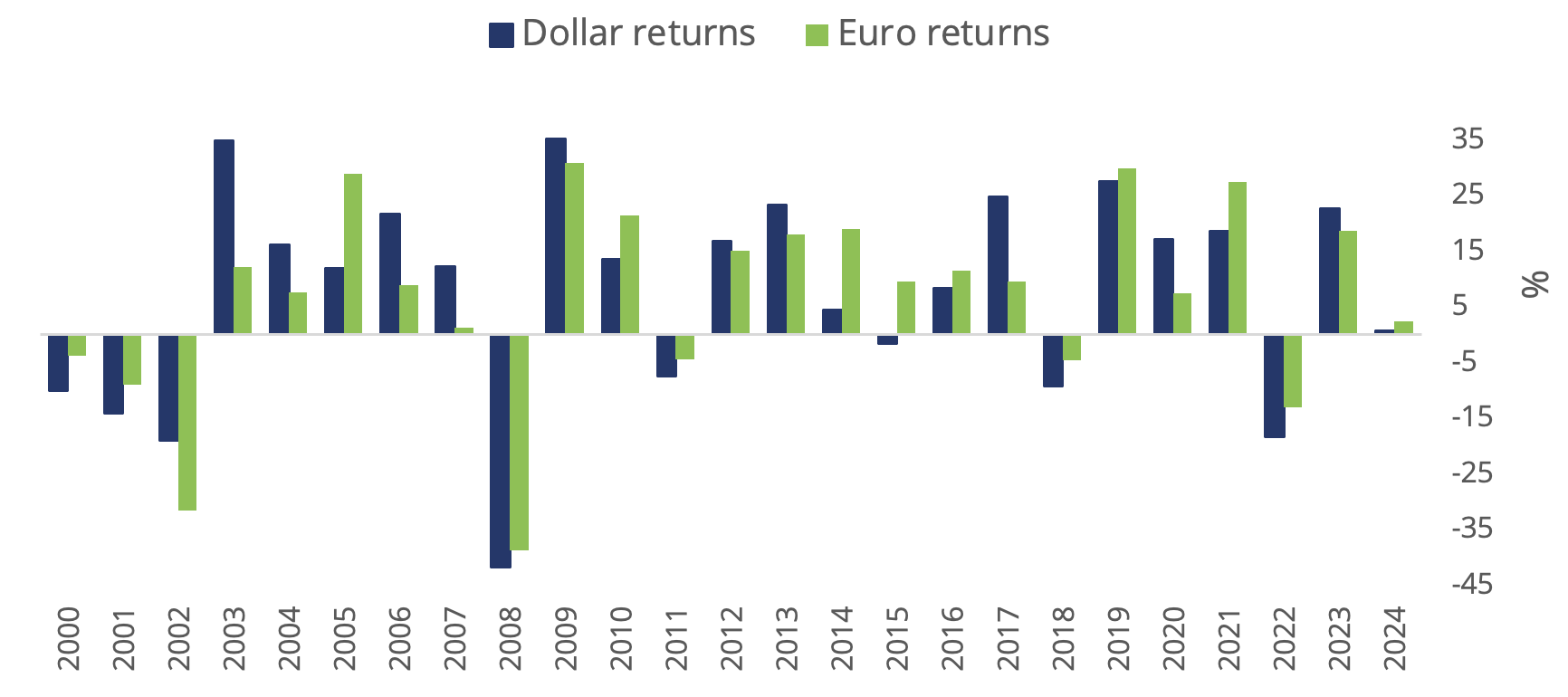Stocks extended gains in January, lifting the STOXX® Global 1800 index to near record highs, as optimism that major central banks will soon start cutting interest rates carried into the new year.
The STOXX Global 1800 rose 1.3% in the month when measured in US dollars and including dividends[1], after gaining 23.9% in 2023 — its best annual showing since 2019. The benchmark traded at less than 1 basis point away from a record high on a price level. It rose 3% in January when measured in euros. The STOXX® World AC index added 0.6% in dollars in the month.
The Eurozone’s EURO STOXX 50® added 3% in euros, while the pan-European STOXX® Europe 600 advanced 1.5%.[2] The STOXX® North America 600 gained 1.6% in dollars, while the STOXX® USA 500 rose 1.7%, trading at an all-time high when excluding dividends. The STOXX® Asia/Pacific 600 climbed 1.5% in dollars. The STOXX® Developed World climbed 1.2% and the STOXX® Emerging Markets dropped 4.1%.
Figure 1: STOXX Benchmark indices’ January risk and return

Figure 2: STOXX Equity World indices’ January risk and return

Germany’s DAX® rose 0.9% in the month. MDAX®, which gauges the performance of German mid-caps, decreased 4.3%.
| For a complete review of all indices’ performance last month, visit our January index newsletter. |
US economy steams ahead
While investors pared down expectations for how soon US interest rates will start falling this year, optimism remains that the Federal Reserve will lower the cost of borrowing even as the economy continues to grow. The US reported on January 25 that the country’s GDP expanded 3.3% in the fourth quarter from the previous three months, beating the 2% consensus in a Bloomberg survey of economists.[3]
Figure 3: Total annual % returns for STOXX World AC index

Figure 4: Select STOXX benchmarks’ returns since 2023

Volatility rises
Despite the rally in equities, the EURO STOXX 50® Volatility (VSTOXX®), which tracks EURO STOXX 50 options prices, rose to 14.8 at the end of last month from 13.6 in December. A higher VSTOXX reading suggests investors are paying up for puts that offer insurance against stock price drops. The VDAX-New®, which measures volatility in German equities, rose to 14.2 from 13.5 in December.
Technology stocks extend rally
Twelve of 20 Supersectors in the STOXX Global 1800 had positive returns in the month, led by the STOXX® Global 1800 Media index (+7.5%)[4]. The STOXX® Global 1800 Technology index, which was the best-performing Supersector in 2023 with a 65.2% jump, came up second in January after a 4.4% increase.
Only six of 25 developed markets tracked by STOXX rose in January when measured in dollars. Nine of 20 emerging markets tracked by STOXX rose in the month.
Factor investing
On a global basis, Momentum had its best month on record relative to the STOXX Global 1800 benchmark, according to the STOXX Factor indices (Figure 5). The Size factor, which tilts towards the smallest-capitalization stocks, was the weakest signal in the month.
Figure 5: STOXX Factor (Global) indices’ January risk and return characteristics

Climate benchmarks
Among climate benchmarks, the STOXX® Global 1800 Paris-Aligned Benchmark (PAB) rose 1.4% and the STOXX® Global 1800 Climate Transition Benchmark (CTB) added 1.5%. The PAB and CTB indices follow the requirements outlined by the European Commission’s climate benchmarks regulation.
Within the STOXX Low Carbon indices, the EURO STOXX 50® Low Carbon (+2.6%) underperformed the EURO STOXX 50 by 37 basis points. Elsewhere, the STOXX® Global Climate Change Leaders (+1.9%), which selects corporate leaders that are publicly committed to reducing their carbon footprint, outperformed the STOXX Global 1800 by 65 basis points last month.
Sustainability indices
The STOXX® Global 1800 ESG-X index gained 1.4% in the month. The STOXX® ESG-X indices are versions of traditional, market-capitalization-weighted benchmarks that observe standard responsible exclusions.
Within indices that combine exclusions and best-in-class ESG integration, the EURO STOXX 50® ESG index rose 3%, in line with its benchmark. Germany’s DAX® 50 ESG index (+0.1%), which excludes companies involved in controversial activities and integrates ESG scoring into stock selection, lagged the benchmark DAX’s return in the month.
Among other STOXX sustainability families, the STOXX® Global 1800 ESG Broad Market added 1.3% in the month. The STOXX ESG Broad Market indices apply a set of compliance, product involvement and ESG performance exclusionary screens on a starting benchmark universe until only the 80% top ESG-rated constituents remain.
The STOXX® Global 1800 ESG Target rose 1%, the EURO STOXX® ESG Target gained 2.3% and the DAX® ESG Target added 1.2%. The STOXX and DAX ESG Target indices seek to significantly improve the benchmark portfolio’s ESG profile while mirroring its returns as closely as possible. Through a series of constraints, the indices implement an optimization process to maximize the overall ESG score of the portfolio while limiting the tracking error to the benchmark.
The STOXX® Global 1800 SRI advanced 3.4%. The STOXX SRI indices apply a rigorous set of carbon emission intensity, compliance and involvement screens, and track the best ESG performers in each industry group within a selection of STOXX benchmarks.
Finally, the DAX® ESG Screened added 0.6% in the month. The index reflects the composition of the DAX benchmark minus companies that fail to pass norms-based and controversial weapons screenings, meet minimum ESG ratings or are involved in certain business activities considered undesirable from a responsible investing perspective.
Thematics, dividend strategies
Only nine of 34 STOXX® Thematic indices outperformed the benchmark STOXX Global 1800 last month. The STOXX® Global Lithium Miners and Producers index was the worst performer after slumping 25.6%.
Dividend strategies had losses in dollars last month. The STOXX® Global Maximum Dividend 40 (-1.3%) selects only the highest-dividend-yielding stocks. The STOXX® Global Select Dividend 100 (-1.9%) tracks companies with sizeable dividends but also applies a quality filter such as a history of stable payments.
Minimum variance
Most minimum variance strategies outperformed last month. The STOXX® Global 1800 Minimum Variance rose 1.4% and the STOXX® Global 1800 Minimum Variance Unconstrained advanced 0.4%.
The STOXX Minimum Variance Indices come in two versions. A constrained version has similar exposure to its market-capitalization-weighted benchmark but with lower risk. The unconstrained version, on the other hand, has more freedom to fulfill its minimum variance mandate within the same universe of stocks.
[1] All results are total returns before taxes unless specified.
[2] Throughout the article, all European indices are quoted in euros, while global, North America, US, Japan and Asia/Pacific indices are in dollars.
[3] ING, “US GDP confounds slowdown fears, but ‘job done’ on inflation,” January 25, 2024.
[4] Figures in parentheses show last month’s gross returns.
